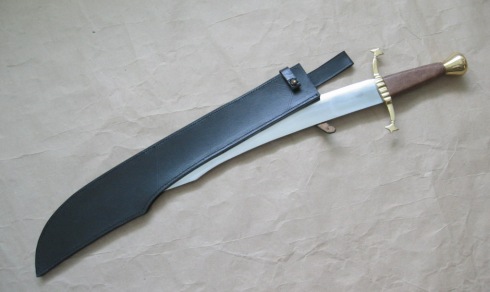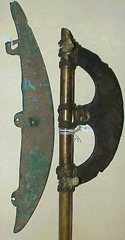Nicholas Palazzo
Well-Known Member
Why not? Anything they didn't carry, they had to leave behind in Nargothrond. Not one Elf came with to help them carry their things.
Because nobody travels in full military gear unless they are on their way to war. Even if the roads can be dangerous.
Right, I agree with you here. The warhammer and mace aren't what I picture though -- rather spears, halberds, and poleaxes.
The curved sword, like full plate harness, appears to be something Tolkien avoided giving to Elves, and I would avoid it too. In fact I think that Elves and Orcs, hating each other, will want to avoid looking alike and will seek to differentiate their armor and weapons from their enemies (within the limits of practical need). And even Noldor probably cannot afford to cover every last soldier in silver and jewels.
Also... I get what you say about evolving military technology. But when Feanor has forged "fell swords for himself and his seven sons" it seems a little odd for masterpieces of metalwork to be discarded 100 years later. Even Curufin would struggle to make their equal.
To dovetail with what Marielle said about Morgoth focusing on quantity over quality, I don't necessarily think that all Orkish foot-soldiers had great armor or full coverage of their extremities. So while they may need chopping weapons and maces and warhammers to damage Elves and Humans and Dwarves through their armor, Elves can use their devastatingly sharp swords (in some cases even cutting poor-quality iron?) on exposed body parts -- and their skill and precision is such that they can target eve tiny chinks in armor. Thus, long sharp swords, and sharp pointy spears.
Getting through troll-hide is a different story -- I don't know what the optimal weapon would be for that. Trollskin is effectively scale armor.
My recommendation for the khopesh is set in a time before the orcs are known, and before the elves have any idea what they are up against, so avoidance of an orcish style wouldn't be applicable here. Also, since we know that the orcs do use straight swords and the elves do not necessarily avoid this, I don't think this is necessarily a valid reason to avoid it. What we can say is that curved blades, as they are not optimized for thrusting, would be less effective against armor, and would likely be avoided, once the elves have a basic understanding of combat.
As to Feanor's weapons, they may be well-forged, but they were made in a state of ignorance. Brilliant Feanor may be as a craftsman, but he has no idea what is going to be needed in actual combat. I think we can extrapolate that swords would grow longer and their points more acute as time went on.
The elves' blades do occasionally cut through iron, but we have to be aware of the fact that this is not a measure of sharpness, but of hardness, strength, and weight. We also cannot necessarily assume that Melkor would continuously ignore evidence that his orcs were underequipped. For example, they were well-equipped enough to demolish the Sindar before Thingol procures sufficient arms and armor. Well-crafted stone weapons can cut exposed body parts just as easily as steel, just ask the British who landed on New Zealand. I think that we can assume that the orcs are at least covering their bodies, arms and necks, using shields, and so on.
As to troll-hide, the best they are going to get are thrusting weapons, axes, and maces. A warhammer's spike would likely puncture a troll's skull just as easily as it would a thick steel helmet. Not to mention, the elves are capable of putting basic enchantments on weapons, and it is likely that they could manage to put troll-bane enchantments on weapons if needed.






